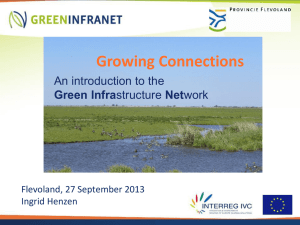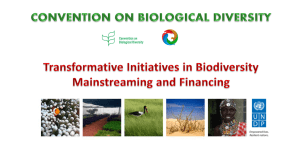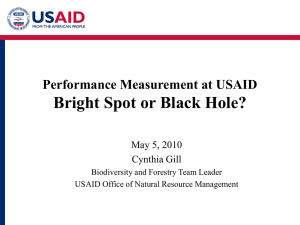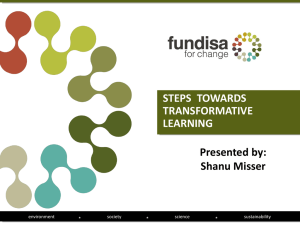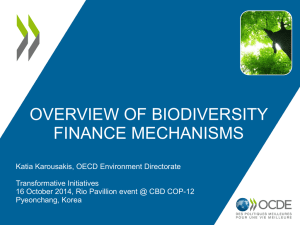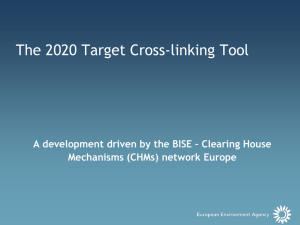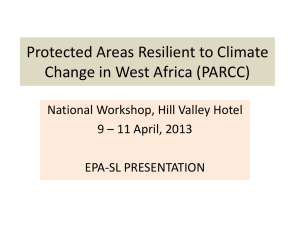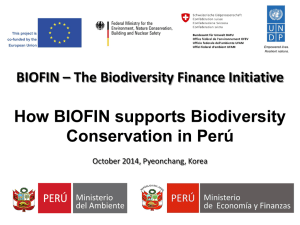why law matters for success
advertisement
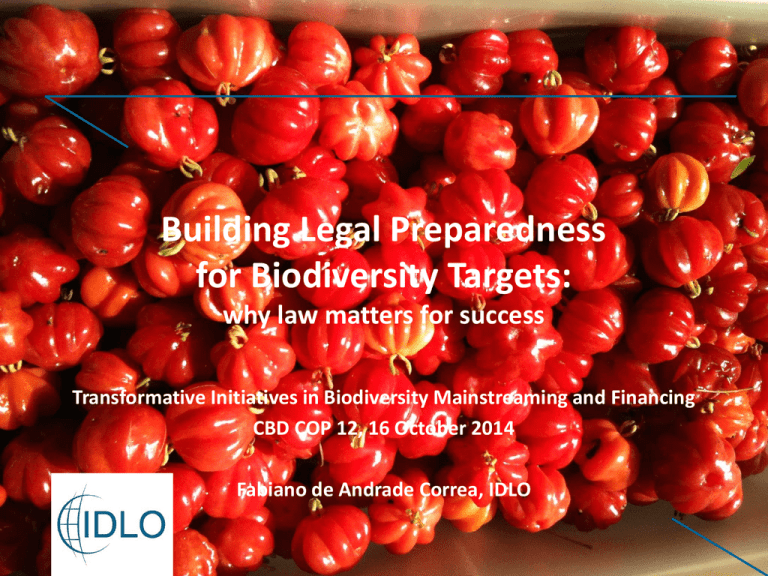
Building Legal Preparedness for Biodiversity Targets: why law matters for success Transformative Initiatives in Biodiversity Mainstreaming and Financing CBD COP 12, 16 October 2014 Fabiano de Andrade Correa, IDLO ‘Legal Preparedness for Achieving the Aichi Targets’: quick overview IDLO: rule of law and a culture of justice for sustainable development. Legal preparedness: assessment of legal frameworks; development of action plans; building capacity of governments and empowering people Countries need tailored legal solutions to biodiversity issues, and incountry legal expertise is key: need to mainstream “biodiversity laws”. Program Mission and Activities Launched in 2012 by the IDLO and CBD Secretariat Objective: To foster global collaborations to define innovative legal solutions and build national legal capacity that can catalyze national efforts to achieve the CBD SP and AT Target Beneficiaries: National legal community across sectors, CBD focal points and officers, and governments, communities, business Main outputs: • • • • • Build up a global network of “biodiversity lawyers” Generating new knowledge on innovative legal solutions Developing practical toolkits on legal preparedness processes Building capacity of lawyers through peer to peer sharing and global networks Next steps: undertaking country programs to build country tailored legal solutions to achieve biodiversity targets What have we done? 2012 Scoping knowledge on the Targets > Launch by IDLO and CBD Secretariat, with support from JBF > Studies by national researchers on promising biodiversity laws (CISDL) 2013 Focusing on key challenges and building partnerships > Focus on Nagoya Protocol (T16), Biodiversity Incentives (T3) and Protected Areas (T11) - scoping papers, country studies > New partnerships with JBF, Swiss FOEN, ABS Capacity Development Initiative, IUCN ELC, Natural Justice and network of national lawyers 2014 Building guidance and capacity of national lawyers > Toolkit on T16 and T3/T11/T14 > Capacity building course on building legal frameworks for the NP/T16 > Piloting for global forum of biodiversity lawyers 2015… Country programs What have we learned? Law can make an effective contribution to biodiversity through: The creation, implementation and enforcement of strong legal frameworks that can mainstream biodiversity and translate international biodiversity goals to national priorities and mechanisms; • (e.g. different laws on impact assessment, Japan NBSAP law, Peru PES law, US laws on Bos) The establishment and proper functioning of responsive and accountable institutions at all levels; • (e.g. Mexico’s CONABIO, India Biodiversity Act) The empowerment of communities and businesses, especially the most vulnerable and marginalized groups, to benefit from the opportunities arising from biodiversity, and to uphold their rights related to the environment and sustainable economic development. • (e.g. Cameroon Forest Act 1994, Namibia’s Nature Conservancy Act, Peru’s TK regime) What have we learned? No one-size fits all legal solution exists > Countries are building “legal frameworks” with a mix of legal and non-legal instruments (legislation, regulations, administrative, policy, negotiated rule-making) Cross-sectoral “sustainable development laws” are needed that go beyond traditional “environmental laws”. > Effective legal frameworks comprise of a mix of legal instruments related to intellectual property, tax law, land use planning, environment, agriculture, forestry, indigenous & human rights, access to information, health, commercial law, contract law… “Success” is being achieved by careful selection of the legal framework tailored to country context and adaptation though learning-by-doing. > The choice of legal instrument depends on the several country-specific factors – purpose, risk, flexibility, capacity. Legal Preparedness can be key to meet biodiversity challenges. What have we learned? Common challenges: Legal uncertainty: blockage for uptake incentives and businesses Implementation and enforcement: law in practice x law on paper Capacity of stakeholders/institutions: ability to mainstream biodiversity and be accountable Need for legal reform: challenge of undertaking a comprehensive process and mainstreaming What can be done? IDLO: Different way of legal reform Developed methodology of legal preparedness used across sectors Benefits: Focus on equitable, sustainable and effective outcomes No one size fits all: need for tailored approach Lawyers need to know tools available and how/when to use tools to bring transformational change Success often achieved by learning by doing: national legal capacity is key and needs to be built, not only legal assistance provided externally How can we change the way we make biodiversity laws? Commit to building “legal preparedness” – the development of country-tailored legal frameworks by a team of national lawyers linked to global expert networks 1 Assess the current legal framework 2 Include Stakeholders in the process 3 Select appropriate legal instruments 4 Implement the legal framework A national legal roadmap Step 1 --- Step 2 --- Step 3 --- Step 4 Assess the current legal framework Only by knowing where we start, can we effectively get to where we want to be. Situation 1 There is a dedicated law for the particular issues Situation 2 measures are embedded within broader environmental laws or other pieces of legislation Situation 3 There is no legal framework for the particular issue Step 1 --- Step 2 --- Step 3 --- Step 4 Stakeholder Engagement Step 1: Identify stakeholders • Who should be involved? Step 2: Identify current stakeholder engagement processes Step 3: Prioritize stakeholders’ involvement • What types of policies, regulations, finance and governance systems are already in place? National Biodiversity Strategy and Action Plans (NBSAP) National development planning documents National budget documents • Identify the importance of each stakeholder group, against different criteria Most influential Most affected Synergies b/w stakeholders Potential conflicts Step 1 --- Step 2 --- Step 3 --- Step 4 Selecting Legal Instruments How to select the most appropriate legal instrument(s)? Legislation Regulatory Requirements Formal Regulations Negotiated rule-making and comanagement Informal Administrative measures Policy measures Step 1 --- Step 2 --- Step 3 --- Step 4 Selecting Legal Instruments Select categories and considerations of national interest Purpose • National interest • Change behavior Flexibility • Ability to address changing requirements Risk • High risk outcomes = prescriptive laws Capacity • Human • Financial • Institutional Step 1 --- Step 2 --- Step 3 --- Step 4 Implementing Legal Reform Effective implementation = • Capacity building + • Legal empowerment + • Monitoring, review and verification + • Active assessment of the success of ABS legal reform SUMMARY STEP 1: Assess the current legal framework 1. Identify your country situation 2. Gap Analysis STEP 2: Include stakeholders in the legal process 1. Stakeholder identification 2. Stakeholder prioritization 3. Legal measures to codify stakeholder engagement STEP 3: Select appropriate legal instruments STEP 4: Implement the legal framework 1. Identify different legal instruments 2. Match country settings to legal instruments 1. Disseminate information and build capacity 2. Establish an assessment framework to measure success Next steps – building up from the foundation Nagoya Protocol Mainstreaming & Economics PAs and OECMs Scoping Paper T16 Scoping Paper T3 Scoping Paper T11/14 Country studies Country studies Country studies - Peru – Law No. 27811, 2002 (TK) - Philippines, Administrative Order No. 1, 2005 - EU Regulation 2014 More… - Brazil – ICMS Ecologico 1991 - U.S. Clean Water Act & Army Corps of Engineer Regulation More… - Fiji Islands, iTaukei Act and iTaukei Lands Trust Act - South Korea, Baekdudaegan Protection Act, 2003 More… Toolkit T16 (2014) Capacity Building Course Toolkit T3, 11, 14 (2014) Thank you!



